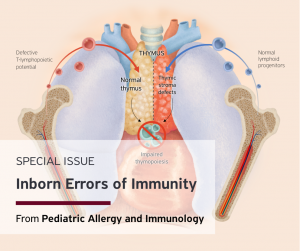Pediatric Allergy and Immunology (PAI)
Pediatric Allergy and Immunology (PAI)

Latest Issues
Special Issue: Inborn Errors of Immunity
 The Editors of PAI – Pediatric Allergy and Immunology, launch a new Virtual Issue on “Inborn Errors of Immunity (IEI)”. It aims to update our knowledge about diagnosis, and clinical management in this demanding area of pediatric immunology. With almost 500 disease entities to date, the task to serve our patients is challenging.
The Editors of PAI – Pediatric Allergy and Immunology, launch a new Virtual Issue on “Inborn Errors of Immunity (IEI)”. It aims to update our knowledge about diagnosis, and clinical management in this demanding area of pediatric immunology. With almost 500 disease entities to date, the task to serve our patients is challenging.
With this issue we hope to foster our clinical decisions and scientific research for the ultimate benefit of our patients living with one of these rare diseases.
Fabio Candotti, Associate Editor, PAI
Philippe Eigenmann, Editor in Chief, PAI
Short Introduction to IEI – Virtual Issue
With this Virtual Issue on “Inborn Errors of Immunity (IEI)” the journal PAI – Pediatric Allergy and Immunology, aims to update our knowledge about diagnosis, and clinical management in this demanding area of pediatric immunology. The increasing acceleration of discoveries in the field of IEI brought about by the advent of next-generation sequencing (NGS) has deeply advanced our abilities to diagnose and treat patients affected by IEIs, as well as our understanding of the mechanisms at work in the immune system in health and disease. At the same time, with almost 500 disease entities to date, the task to serve our patients is challenging. Therefore, we have invited leaders in the field to contribute a collection of reviews that elucidate the pathways and defects in the DNA damage response, give insights into the defects of thymic development and of self-tolerance checkpoints, and cover the CD28 family of receptors to help us understand the defects of terminal B cell differentiation. Additional reviews of the areas of IEIs characterized by disorders of actin cytoskeletal dynamics, JAK-STAT signaling, and type I interferon responses have been commissioned and will be available shortly. A complementing selection of articles recently published in PAI that highlights clinical observations from cohort studies of well-known conditions, as well as original discoveries that extend the genetic and clinical features of less commonly observed IEIs, is also featured in this collection.
We are confident you will enjoy the reading and hope that this Virtual Issue will foster our clinical decisions and scientific research for the ultimate benefit of our patients living with one of these rare diseases.
Fabio Candotti, Associate Editor, PAI
Philippe Eigenmann, Editor in Chief, PAI